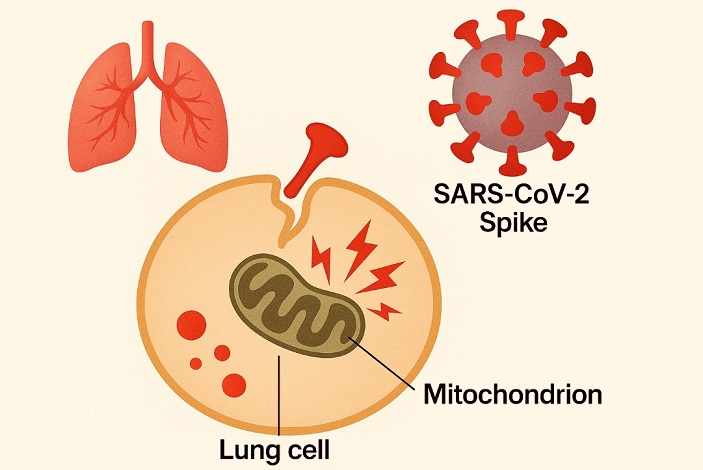SARS-CoV-2 Spike Triggers Mitochondrial Chaos and Lung Inflammation in Long COVID via COX-2 Palmitoylation
Nikhil Prasad Fact checked by:Thailand Medical News Team May 10, 2025 6 months, 34 minutes ago
Medical News: Scientists Reveal Dangerous Role of Spike Protein in Long COVID Lung Damage and Inflammation
A major new study from researchers at Xiamen University in China has uncovered how the spike protein of the SARS-CoV-2 virus could be causing long-term lung inflammation and damage in people suffering from post-acute COVID-19 syndrome, also known as Long COVID. The study shows how a small molecular change in an inflammatory protein known as COX-2, triggered by the spike protein, leads to mitochondrial malfunction, cell death, and persistent lung problems even after the virus has left the body.
 SARS-CoV-2 Spike Triggers Mitochondrial Chaos and Lung Inflammation in Long COVID via COX-2 Palmitoylation
SARS-CoV-2 Spike Triggers Mitochondrial Chaos and Lung Inflammation in Long COVID via COX-2 Palmitoylation
The research was carried out by scientists from the State Key Laboratory of Vaccines for Infectious Diseases, Xiang An Biomedicine Laboratory, Xiang’an Hospital of Xiamen University, and the School of Public Health, Xiamen University. In this
Medical News report, we explore the disturbing new findings and how they might help explain why so many people continue to suffer respiratory symptoms months or even years after an initial COVID-19 infection.
The Hidden Trigger COX-2 and Its Deadly Palmitoylation
The study focused on a specific inflammatory enzyme called COX-2, which is already known to be involved in swelling, pain, and fever. The researchers discovered that when the SARS-CoV-2 spike protein enters lung cells, it causes a modification of the COX-2 protein at a specific location (called cysteine 555) through a process known as palmitoylation. This change allows COX-2 to attach itself to a key mitochondrial enzyme called hexokinase 2 (HK2).
This molecular interaction sets off a dangerous chain reaction: mitochondria, the energy factories of cells, begin to malfunction. The cells switch from healthy energy production to a harmful process called glycolysis, similar to what’s seen in cancer cells. This leads to a dramatic increase in inflammatory chemicals, a form of explosive cell death known as pyroptosis, and damage to lung tissue.
Spike Protein Alone Is Enough to Wreak Havoc
In laboratory tests, scientists introduced the spike protein into mice and human lung cells without using the full virus. The result was the same—COX-2 was palmitoylated, mitochondria were damaged, and inflammation exploded. This means the spike protein by itself, such as the one still circulating in the body after infection or vaccination, can be enough to cause persistent lung problems.
Importantly, the team discovered that blocking palmitoylation using drugs or genetic tools reversed this damage. Mice treated with palmitoylation inhibitors had less lung damage, reduced inflammation, and better overall respiratory health.
A New Target for Long COVID Treatment DHHC5
The enzyme responsible for this damaging palmitoylation is called DHHC5. When scientists blocked DHHC5 in animal models, the spike protein could no longer trigger mitoch
ondrial breakdown and inflammation. Lung tissues appeared healthier, with less fluid leakage, collagen buildup, and inflammation markers.
Even more strikingly, long-term exposure to the spike protein in mice triggered signs of neuro-olfactory issues similar to those seen in Long COVID sufferers—including brain inflammation, olfactory dysfunction, and cognitive problems. Once again, DHHC5 blockade reduced these symptoms, suggesting that this enzyme could be a powerful target not only for respiratory issues but also neurological symptoms associated with Long COVID.
Conclusions and Implications
This groundbreaking study provides strong evidence that the spike protein of SARS-CoV-2, even without the rest of the virus, is capable of triggering long-lasting damage in the lungs and brain through a single molecular pathway involving COX-2 palmitoylation and mitochondrial reprogramming. These findings could explain why many Long COVID patients continue to suffer from fatigue, breathlessness, and brain fog long after clearing the infection.
By targeting the DHHC5 enzyme or blocking COX-2 palmitoylation, it may be possible to develop new treatments that reverse or prevent these lingering symptoms. The work also raises important questions about the long-term effects of spike protein exposure from infections and possibly repeated vaccinations. As the world grapples with the burden of Long COVID, these new insights offer hope for therapeutic breakthroughs.
The study findings were published in the peer reviewed Journal of Advanced Research.
https://www.sciencedirect.com/science/article/pii/S2090123225002991
For the latest Long COVID news, keep on logging to Thailand
Medical News.
Read Also:
https://www.thailandmedical.news/news/taurine-protects-mitochondria-and-supports-cellular-health
https://www.thailandmedical.news/news/covid-19-and-polg-related-mitochondrial-disease
https://www.thailandmedical.news/news/university-of-south-florida-study-shows-that-palmitoylation-of-sars-cov-2-spike-protein-is-essential-for-cell-entry-and-the-formation-of-syncytia
https://www.thailandmedical.news/articles/coronavirus
https://www.thailandmedical.news/articles/long-covid
https://www.thailandmedical.news/pages/thailand_doctors_listings
